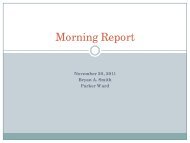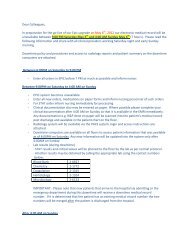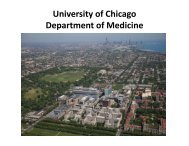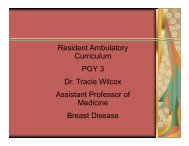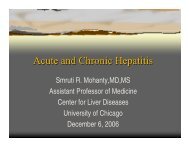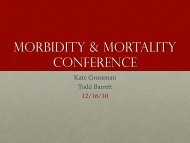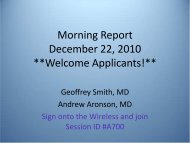Honc: Late recurrence of breast CA
Honc: Late recurrence of breast CA
Honc: Late recurrence of breast CA
Create successful ePaper yourself
Turn your PDF publications into a flip-book with our unique Google optimized e-Paper software.
Morning Report<br />
August 11, 2011<br />
Nancy Luo<br />
Dr. H<strong>of</strong>fman<br />
Please Swipe!!<br />
1
MKSAP Question<br />
A 54-year-old postmenopausal woman is<br />
evaluated after she discovered a right axillary<br />
mass. She is otherwise healthy. She has never<br />
smoked cigarettes and drinks alcohol only<br />
socially. Family history is significant for her<br />
mother who developed <strong>breast</strong> cancer at age 62<br />
years.
MKSAP Question<br />
On physical examination, temperature is<br />
normal, blood pressure is 138/78 mm Hg, pulse<br />
rate is 64/min, and respiration rate is 16/min;<br />
BMI is 19. Thyroid examination is normal. A<br />
mobile, nontender 2-cm axillary lymph node<br />
mass is noted. There is no palpable <strong>breast</strong> mass<br />
or other lymphadenopathy.
MKSAP Question<br />
An excisional biopsy reveals adenocarcinoma.<br />
Results <strong>of</strong> mammography and <strong>breast</strong> MRI are<br />
normal. The complete blood count, metabolic<br />
panel, urinalysis, and chest radiograph are<br />
normal. Immunohistochemical staining results<br />
are positive for CK-7 and are negative for CK-20,<br />
estrogen receptor and progesterone receptor,<br />
and TTF-1 expression.
MKSAP Question<br />
Which <strong>of</strong> the following is the most appropriate<br />
next step in management?<br />
1. Chest CT scan<br />
2. Panendoscopy <strong>of</strong> the aerodigestive tract<br />
3. Right mastectomy and axillary lymph node<br />
dissection<br />
4. Thyroid ultrasonography
Please make your selection...<br />
1. Chest CT scan<br />
2. Panendoscopy <strong>of</strong> the<br />
aerodigestive tract<br />
3. Right mastectomy<br />
and axillary lymph<br />
node dissection<br />
4. Thyroid<br />
ultrasonography<br />
25% 25% 25% 25%<br />
1 2 3 4
MKSAP Question<br />
Although most cases <strong>of</strong> unilateral axillary<br />
lymphadenopathy in women are benign, when a<br />
malignancy does occur, it is most commonly <strong>breast</strong><br />
cancer. Other tumors manifested by axillary lymph node<br />
metastasis include those <strong>of</strong> the lung, thyroid, head and<br />
neck, skin, and gastrointestinal tract. The primary site<br />
remains unknown in about 30% <strong>of</strong> patients. Patients<br />
with axillary lymphadenopathy, negative imaging<br />
studies, and positive findings on immunohistochemical<br />
analysis supportive <strong>of</strong> a diagnosis <strong>of</strong> occult <strong>breast</strong> cancer<br />
should receive treatment according to established<br />
guidelines for stage II <strong>breast</strong> cancer.
HPI<br />
69 year old female who presents to Urgent Care<br />
with nausea<br />
9
HPI Summary<br />
• Nausea and associated retching for a month<br />
• Improves with food intake, then worsens couple hours<br />
after<br />
• Regurgitation <strong>of</strong> mucus or partially digested food<br />
• No burning pain<br />
• Loss <strong>of</strong> appetite, early satiety, weight loss 5#, fatigue<br />
• LUQ constant dull pain<br />
• States this happened in 2009<br />
• Baseline diarrhea (up to 3 loose BM a day) unchanged<br />
and does not make nausea better<br />
• Denies fever/chills, melena/BRBPR, headache, chest<br />
pain, shortness <strong>of</strong> breath. Worsening dry cough recently.<br />
10
PMH Medications<br />
• Type 2 diabetes 12 years<br />
• Chronic depression/fatigue<br />
• GERD<br />
• H/o mild dysphagia x2yrs<br />
• Subclinical <strong>CA</strong>D<br />
• HTN<br />
• Hyperlipidemia<br />
• Breast cancer in remission, s/p<br />
mastectomy 2000<br />
• R arm lymphedema since<br />
2000<br />
• Stress urinary incontinence<br />
• Chronic venous insufficiency,<br />
L>R leg<br />
• DJD <strong>of</strong> cervical spine<br />
• Obesity<br />
• Prevacid 60mg daily<br />
• Prozac 20mg daily<br />
• Lantus 17 units daily<br />
• Glipizide 10mg BID<br />
• Ascarbose 25mg TID<br />
• Pioglitazone 30mg daily<br />
• Metformin 1000mg BID<br />
• Lipitor 20mg daily<br />
• Avalide 300/25mg daily<br />
• Amlodipine 10mg daily<br />
• Oxybutynin 5m BID<br />
• Imodium AD 2 mg prn<br />
• Aspirin 81mg<br />
• Vitamin E and D<br />
next<br />
11
Oncologic History<br />
The patient had a screening mammogram in 05/2000 which revealed<br />
a 4.3 cm mass which was found behind the right nipple. In 09/2008,<br />
underwent right radical mastectomy with lymph node dissection.<br />
Pathology revealed invasive ductal adenocarcinoma, SDR grade 2 <strong>of</strong><br />
3. Surgical resection margins were clean and 1 <strong>of</strong> 25 lymph nodes<br />
were positive. ER is immunochemically very positive. PR is<br />
moderately positive and HER-2 was also positive. She underwent 4<br />
cycles <strong>of</strong> Adriamycin and Cytoxan without Taxol, as well as 6 weeks <strong>of</strong><br />
XRT all completed in 2000. CT <strong>of</strong> the chest and bone scan 01/2002<br />
revealed no definite evidence <strong>of</strong> metastatic disease. Subsequent yearly<br />
diagnostic mammograms revealed no <strong>recurrence</strong> <strong>of</strong> cancer. She<br />
completed 5 years <strong>of</strong> antiestrogen therapy. Patient does not follow<br />
with oncologist.<br />
back<br />
12
Past Surgical History Social History<br />
• Right mastectomy 2000<br />
• ORIF L ankle 9/2008<br />
• Cholecystectomy 1980<br />
Allergies<br />
Adenosine, Phenobarbital,<br />
Venlafaxine, Tamoxifen,<br />
Anastrozole, Sucralfate<br />
• Married to a statistician at U <strong>of</strong><br />
C<br />
• Used to distribute Cephalon<br />
cookware, now retired.<br />
• Denies alcohol<br />
• 30 pack year remote smoking<br />
history<br />
• Denies illicit drugs<br />
Procedural history<br />
EGD 2009: Normal esophagus. Bilious<br />
fluid found in cardia and in gastric<br />
body. Localized mildly erythematous<br />
mucosa found in gastric antrum.<br />
Otherwise normal stomach.<br />
-bilious gastric fluid may have been<br />
secondary to delayed gastric emtying<br />
or bile reflux<br />
-recommended upper GI series and<br />
gastric emptying study (not complete)<br />
13
Physical Exam<br />
• BP 100/52 Pulse 88 Ht 5’5” Wt 238 lb<br />
• GEN: Pleasant, obese, somewhat anxious in no acute distress<br />
• HEENT: Sclerae clear, MMM<br />
• NECK: Supple. No supraclavicular or axillary adenopathy<br />
• CHEST: Lungs clear to auscultation and percussion<br />
• HEART: Regular rate rhythm. No murmurs/rubs/gallops.<br />
• ABDOMEN: S<strong>of</strong>t, minimally tender in epigastric region<br />
without mass or organomegaly<br />
• EXTREMITIES: Non-pitting leg edema. R arm edematous.<br />
• MUSCULOSKELETAL: Gait is narrow-based and steady.<br />
• NEURO: Non focal, A&O x3<br />
• PSYCH: Mood is dysthymic. Patient is articulate, but worried<br />
in a nonspecific manner<br />
14
Differential diagnosis?<br />
15
Differential<br />
Nausea/Vomiting<br />
16
Plan <strong>of</strong> action?<br />
• Labs<br />
• Empiric Rx<br />
18
Labs<br />
13.7<br />
9.2 261<br />
38.9<br />
HbA1C 7.5<br />
132 94<br />
4.1 26<br />
17<br />
1.1<br />
264<br />
9.9<br />
7.8<br />
0.5<br />
4.3<br />
18 19<br />
131<br />
Onc hx<br />
19
Clinic course<br />
• Patient diagnosed with dyspepsia versus delayed<br />
gastric emptying<br />
• Given omeprazole BID with improvement<br />
• Over 2-3 urgent care visits…<br />
• H pylori checked<br />
• Sent for gastric emptying study<br />
• Sent for small bowel follow through<br />
• Prescribed ondansetron with improvement in<br />
symptoms<br />
20
Mechanism <strong>of</strong> Nausea and Emesis<br />
• Coordination between CNS, PNS, GI tract<br />
• Brainstem:<br />
▫ “vomiting center” or central pattern generator<br />
Indistinct collection <strong>of</strong> nuclei in medulla<br />
Coordinates efferent respiratory, GI, autonomic activity associated with<br />
n/v<br />
Final effector pathway through which a variety <strong>of</strong> afferent stimuli can<br />
activate emesis<br />
▫ Area Postrema aka “chemoreceptor trigger zone”<br />
Circumventricular, caudal end <strong>of</strong> 4 th ventricle<br />
Outside BBB, accessible to emetic stimuli borne in blood or CSF<br />
Important source <strong>of</strong> afferent input to vomiting center<br />
Muscarinic, dopamine, serotonin, nerukinin-1, histamine receptors<br />
• Higher brainstem/Cortex<br />
• Vagus and Splanchnic nerves – carry input from GI tract<br />
(terminates in brainstem in nucleus tractus solitarius)<br />
21
Neurotransmitters <strong>of</strong> clinical<br />
significance<br />
• Dopamine<br />
▫ D-2 antagonists<br />
▫ Metoclopramide, Prochlorperazine (Compazine)<br />
• Serotonin (5-HT)<br />
▫ Selective antagonists 5-HT3 receptor<br />
▫ Ondansetron (Z<strong>of</strong>ran), palonosetron (Aloxi)<br />
▫ Side effect: constipation, mild HA,<br />
• Substance P<br />
▫ Neurokinin-1-receptor antagonists<br />
▫ Aprepitant (Emend)<br />
• Endocannabinoids<br />
▫ Dronabinol and nabilone<br />
▫ Side effects: postural hypotension, dysphoria<br />
23
6 weeks later, returns to PCP…<br />
• Nausea persists<br />
• No emesis for 4 weeks<br />
• Unable to walk more than half a block<br />
• Weight loss and loss <strong>of</strong> appetite<br />
• H Pylori Ab 0.34<br />
• Gastric emptying: normal<br />
• UGI series: enlarged fundus <strong>of</strong> the stomach and<br />
delayed gastric emptying<br />
Onc hx<br />
24
Next steps?<br />
• Refer<br />
• Endoscopy<br />
• Imaging<br />
25
Indications for referral<br />
26
Referral to GI<br />
• Repeat Endoscopy: Tortuous esophagus. Gastric<br />
mucosal abnormality characterized by erythema.<br />
Pathology normal.<br />
27
CT Abd/Pelv<br />
• Metastatic disease. Bilateral adrenal lesions and<br />
right iliac bone metastasis. Primary<br />
adrenocortical carcinoma (left adrenal gland<br />
lesion) with metastatic disease is a primary<br />
consideration although certainly other<br />
metastatic neoplasms (such as lung cancer) can<br />
present similarly.<br />
• Onc Hx<br />
28
Admission<br />
• States she is wheelchair bound<br />
• More history?<br />
• Workup?<br />
29
MRI Head<br />
• Multiple lesions in the brain stem and right<br />
parietal and frontal lobes are suspicious for<br />
metastatic disease given the patient’s clinical<br />
history. Although metastases is the most likely<br />
diagnosis a non-neoplastic diagnosis cannot be<br />
entirely excluded.<br />
30
Bone Scan<br />
• Right iliac crest lesion<br />
31
CT Chest<br />
• RUL pulmonary nodule highly suspicious for<br />
malignancy. Differential diagnosis for this<br />
includes primary lung cancer or metastatic<br />
disease. Bilateral adrenal gland masses also<br />
highly suspicious for malignancy.<br />
32
Laboratory testing<br />
• Aldosterone
Brain metastasis<br />
• Any cancer can metastasize to brain (up to 25%<br />
<strong>of</strong> patients dying <strong>of</strong> cancer)<br />
• Lung, <strong>breast</strong>, and melanoma most common<br />
• 90% supratentorial: most commonly gray/white<br />
matter junction, and in watershed areas <strong>of</strong> brain<br />
• Focal or generalized symptoms, but subtle<br />
• 50% have headaches, may also may present with<br />
acute seizures, symptoms <strong>of</strong> increased ICP<br />
• MRI is most sensitive and specific<br />
34
Increased intracranial pressure : an<br />
oncologic emergency<br />
• Resulting from brain edema and tumor expansion<br />
• Nausea specifically by edema or mass at/near area postrema <strong>of</strong> the medulla<br />
• Triggered emesis by change in body position<br />
• Headache, depressed consciousness, CN VI palsies, papilledema,<br />
spontaneous periorbital bruising, focal symptoms <strong>of</strong> herniation<br />
▫ Cushing’s triad (bradycardia, respiratory depression, hypertension)<br />
• Treat symptoms<br />
• Dexamethasone (most lipid soluble)<br />
▫ 4-16mg daily in divided doses (up to 24mg IV initially if very symptomatic)<br />
• Antiepileptics<br />
▫ Prophylaxis not necessary<br />
• Hyperventilation/IV Mannitol/invasive ICP monitoring as indicated<br />
• Surgery<br />
▫ Solitary metastasis, oligometastases (
Sir William Richard Gowers<br />
(20 March 1845 – 4 May 1915)<br />
“Cerebral vomiting may be, and <strong>of</strong>ten is, unattended by<br />
nausea, but this is not an invariable characteristic. In some<br />
cases nausea is distressing… the coexistence <strong>of</strong> persistent<br />
pain in the head, with frequent vomiting, should always<br />
raise a suspicion <strong>of</strong> cerebral disease… Patients who vomit<br />
without other indications <strong>of</strong> gastro-intestinal disturbance<br />
should be carefully watched.”<br />
- Gowers. A manual <strong>of</strong> diseases <strong>of</strong> the nervous system. 1888<br />
36
Neurological symptoms mistaken for<br />
gastrointestinal disease: review<br />
• Report from 1998, 25 patients neurologic symptoms mistaken for GI<br />
disease over previous 23 years at USC/LA County (55,000/year)<br />
▫ Most had nausea, some dysphagia/abd pain<br />
▫ Most common diagnosis: gastritis/gastroenteritis, gastric outlet<br />
obstruction, duodenal ulcer, dysphagia<br />
▫ Many had contrast radiography, 6 had endoscopy (2 had unnecessary<br />
operations)<br />
▫ 13/25 had a diagnosis delay <strong>of</strong> 5.5 months<br />
▫ On admission to a neurology service<br />
neurological symptoms elicited in 20/25: headache, vertigo/dizziness,<br />
ataxia, diplopia, hoarseness, tinnitis, visual loss, stiff neck<br />
neurological signs elicited 23/25: nystagmus, pupillary abnormalities,<br />
papilledema, bulbar weakness, ataxia/tremor, limb numbness<br />
▫ Nausea was most common and most ambiguous symptoms<br />
▫ Vomiting out <strong>of</strong> proportion to dizziness was confusing<br />
▫ Abdominal pain- can occasionally be a symptoms <strong>of</strong> spinal disease, or<br />
caused by repeated vomiting<br />
37
Patient course<br />
• Started on oral decadron with symptom<br />
improvement over 48 hours<br />
• Whole brain radiation for 2 weeks<br />
• Interventional radiology performed a CT guided<br />
biopsy <strong>of</strong> the R iliac lesion<br />
▫ Pathology: metastatic carcinoma morphologically<br />
consistent with <strong>breast</strong> primary<br />
▫ Strong ER positive 90% cells, PR expressed 5-10%<br />
cells, HER2 negative, TTF-1 negative<br />
38
Breast cancer and cancer dormancy<br />
• Cancer dormancy<br />
▫ An unusually long time between removal <strong>of</strong> the<br />
primary tumor and subsequent relapse in a<br />
patient who has been clinically disease-free<br />
▫ Analogous to chronic disease model<br />
• Breast cancer, 20% clinically disease-free patient<br />
relapse 7-25 years after mastectomy<br />
▫ From 10 to 20 years, rate <strong>of</strong> relapse is relatively<br />
steady at about 1-1.5% per year<br />
39
Primary Tumor<br />
CTCs<br />
Bone Marrow<br />
Expansion to steady state<br />
Dormancy<br />
Loss <strong>of</strong> steady state<br />
(relapse)<br />
Growing metastasis<br />
40
Circulating tumor cells<br />
• Circulating tumor cells have been found in patients<br />
in long remission (clinically cured) at rates higher<br />
than reported risk <strong>of</strong> <strong>recurrence</strong><br />
• Usually have short half life in blood<br />
• Must have a source <strong>of</strong> replicating cells<br />
(micrometastasis or bone marrow)<br />
• Balance between replication and cell death, though<br />
mechanism <strong>of</strong> control unknown<br />
• Statistically NOT all <strong>of</strong> these patients found will<br />
develop clinical <strong>recurrence</strong>, though increased risk is<br />
unknown<br />
• Treatment?<br />
41
Brain metastasis in HER2+ <strong>breast</strong><br />
cancer treated with Herceptin<br />
• HER2-positive <strong>breast</strong> cancer patients may have<br />
significantly higher incidence <strong>of</strong> CNS metastasis<br />
after treatment with trastuzumab (Herceptin)<br />
• HER2+ tends for more aggressive phenotype<br />
• Trastuzumab overcame adverse prognostic<br />
significant <strong>of</strong> HER2 positivity<br />
• Large monoclonal antibody that does not cross the<br />
BBB<br />
• Improvement in systemic control and survival may<br />
led to “unmasking” <strong>of</strong> CNS disease <strong>recurrence</strong><br />
• Brain may act as “sanctuary site”<br />
42
Follow up<br />
• After completion <strong>of</strong> palliative whole brain<br />
radiation…<br />
▫ Strength has improved remarkably<br />
▫ Able to climb 27 stairs<br />
▫ No nausea or headaches<br />
• Started on aromatase inhibitor<br />
43
References<br />
• Keane JR. Neurologic symptoms mistaken for gastrointestinal disease.<br />
Neurology 1998;50:1189-1190.<br />
• Squires RH. Intracranial tumors: vomiting as a presenting sign. Clin<br />
Pediatrics 1989;28:351-354.<br />
• Hesketh PJ. Chemotherapy-induced nausea and vomiting. N Engl J Med<br />
1008;358:2482-94.<br />
• Halfdanarson TR, Hogan WJ, Moynihan TJ. Oncologic emergencies:<br />
diagnosis and treatment. Mayo Clin Proc. 2006;81 (6):835-848.<br />
• Uhr JW, Pantel K. Controversies in clinical cancer dormancy. PNAS<br />
2011;108:12396-12400<br />
• Meng SD, et al. Circulating tumor cells in patients with <strong>breast</strong> cancer<br />
domrancy. Clin Cancer Research 2004;10:8152-8162<br />
• Musolino A, et al. Multifactorial central nervous system <strong>recurrence</strong><br />
susceptibility in patients with HER2-positive <strong>breast</strong> cancer. Cancer<br />
2011;117:1837-1846<br />
• Scorza K, et al. Evaluation <strong>of</strong> nausea and vomiting. AM FP 2007;76:76-84.<br />
44
PLEASE SWIPE!



